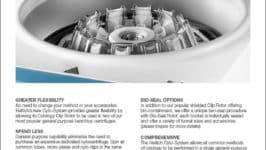Bronchial Washings Application Note
This application note provides information on specific application methods and the use of Hettich products. (more…) read more...
File size: 211.0 kb
Bronchial washing is the flushing of the respiratory tract with a physiological saline solution. This procedure is used to derive cellular material and/or any invaded foreign bodies, for examination under a microscope.
Bronchial washings from healthy non-smokers comprise approximately 90% macrophages and a maximum of 15% lymphocytes, up to 3% granulocytes and 0.5% eosinophils. A washing is rich in cells and in most cases also contains mucus. In patients with certain diseases, this cellular constitution changes and provides valuable information to aid diagnosis.
The presence of inhaled foreign bodies such as asbestos particles and pathogens (e.g., tubercle bacteria and pneumocystis carinii in patients with AIDS) can be detected directly.
Therefore, cytological preparations are derived from bronchial washings for the diagnosis of a large number of pulmonary and respiratory diseases. The preparations can be stained immunocytochemically or by using Pappenheim’s staining method with the Hettich centrifuges.
ADVANTAGES OF THE HETTICH METHOD
1) Easy preparation
2) Excellent preparation quality
PREPARATION
1) Sample preparation
Since bronchial washings often contain mucus which would affect the quality of the preparation, the mucus should be removed in advance. The washing is therefore filtered through 2 layers of gauze.
2) Suitable accessories
As the washing is rich in cells, 2 ml and 4 ml chambers with sediment areas of 60 mm2 or 120 mm2 should be used. The sample volume to be filled into the chambers depends on the cell content. Every mm2 of sediment area in the chamber should contain between 1,000 and 2,000 cells – so approx. 60,000 to 120,000 cells should be filled into the 60 mm² chamber and 120,000 to 240,000 into the 120 mm2 chamber. (The number of cells can be determined with a Fuchs-Rosenthal counter).
3) Assembly of the cyto insert
How to assemble a cyto insert can be learned from our leaflet “Perfect preparations – with the HETTICH cyto-system all it takes is a turn”. Microscope slide preparations derived from a bronchial washing are centrifuged, then air-dried. For this reason, the insert should be assembled without a filter card (see illustration A1 in the above-mentioned leaflet). When working with infectious samples, the inserts should be closed with lid no. 1661 (see illustration A2 in the leaflet) to prevent the escape of aerosols.
CENTRIFUGATION
a) Sedimentation: Centrifuge the cyto chambers for 20 minutes at 275 x g (this corresponds to 1,500 min-1 with the 6-place rotor and 1,700 min-1 with the 4-place rotor).
b) Removal of the cell-free supernatant: After centrifugation, the cell-free supernatant is still in the chamber and should be removed as completely as possible through careful pipetting. This step is not necessary if Dr. Barkhofen’s method is used (see c, 2.)
c) Drying of the sediment
There are different approaches to drying the sediment:
1) After pipetting-off, the supernatant, remove the cyto chamber (see illustration A4 in the leaflet) and allow the sediment to air dry.
2) After centrifugation, take the cyto insert out of the centrifuge and tilt it to one side to allow the liquid to flow out. Leave the cyto insert in this position for at least 1 hour to dry or for longer if possible (e.g., overnight). Then remove the cyto chamber and allow the remaining ring of liquid residue to air dry. (Method of Dr. Barkhofen [Schillerhöhe Stuttgart/Gerlingen])d) Fixing and staining: The dry preparation can now be fixed and stained.
Good to know: With the Giemsa and the May-Grünwald-Giemsa staining methods, the microscope slides are rinsed with a buffer (e.g. Weise or Sörensen) after staining. Thereafter, they need to be dried. This can be done quick and easy with the labora-system frame for 6 slides (Cat. No. 1285). Put the slides rinsed in buffer in the frames and centrifuge them for 1 minute at 275 x g (this corresponds to 1,500 min-1 in the 6-place rotor and 1,700 min-1 in the 4-place rotor).
Hettich products are designed to help you achieve optimal results for your application and are built to perform to the specifications outlined in the operators manual. For application-specific information and settings, please refer to your organization’s standard operating procedure. As always, our Hettich representatives are here to help determine which Hettich products and accessories best fit your laboratory requirements.

This application note provides information on specific application methods and the use of Hettich products. (more…) read more...

This brochure provides information on the Hettich Cyto System rotors and accessories. (more…) read more...

This product sheet provides a detailed overview of the product features, benefits and models. (more…) read more...
Hettich manufactures centrifuges for any standard laboratory application.